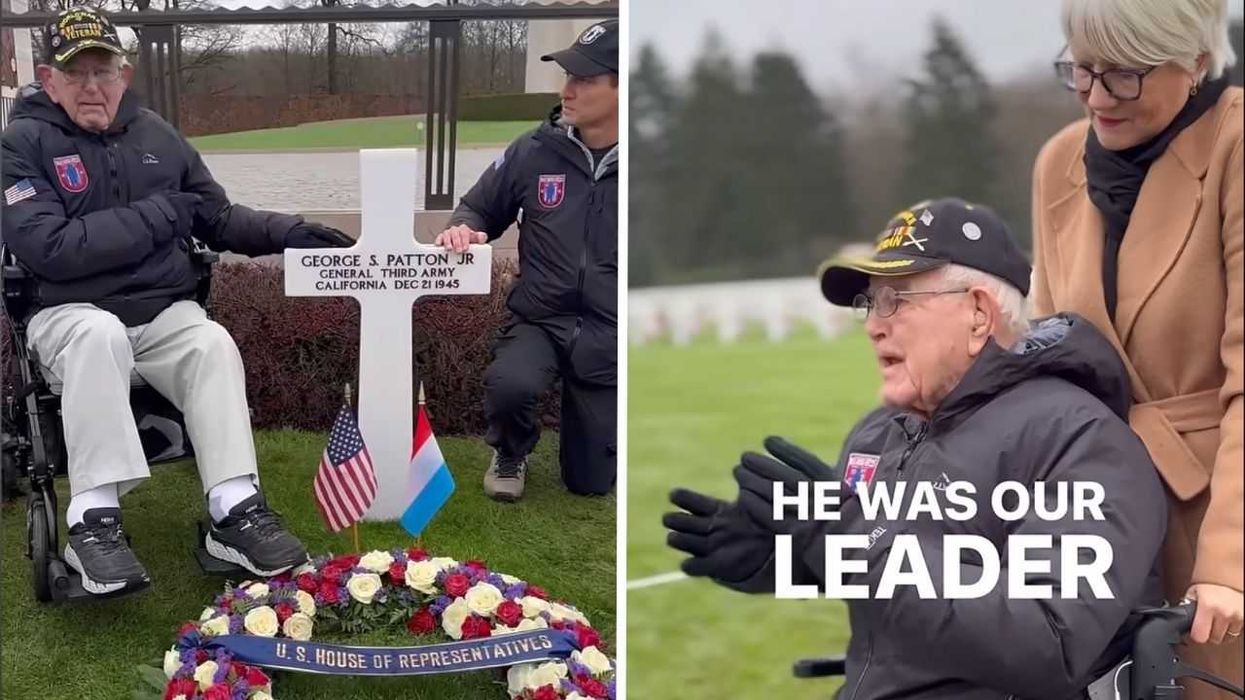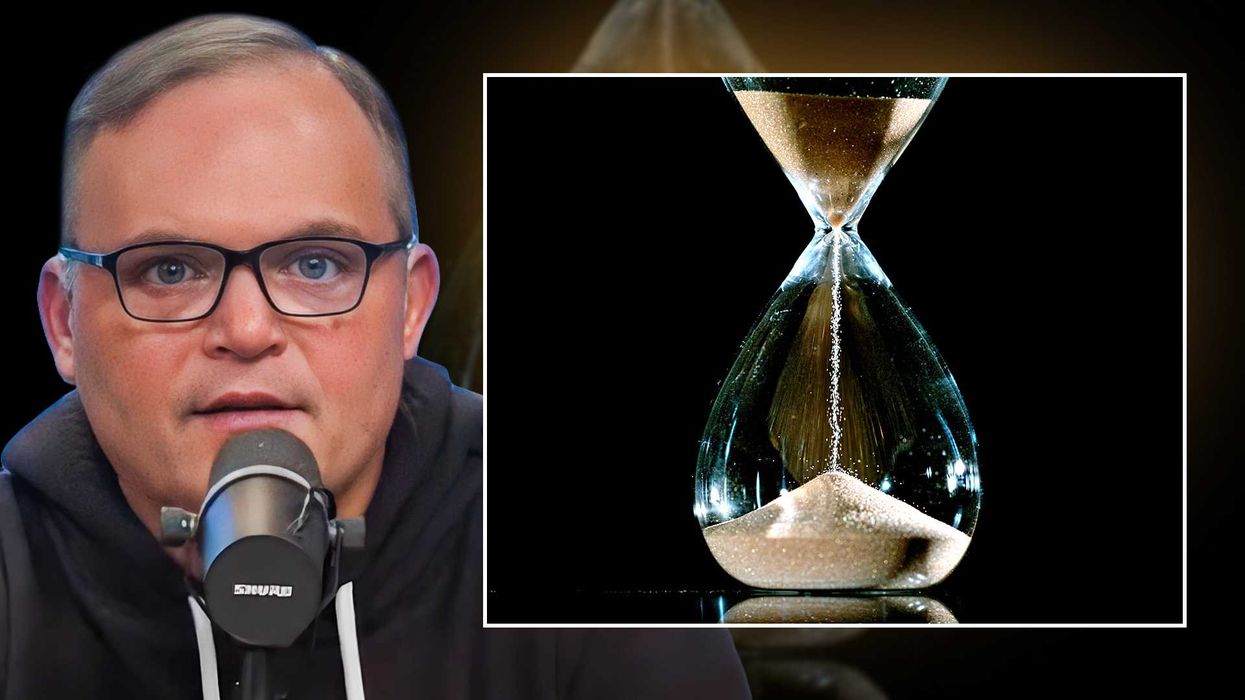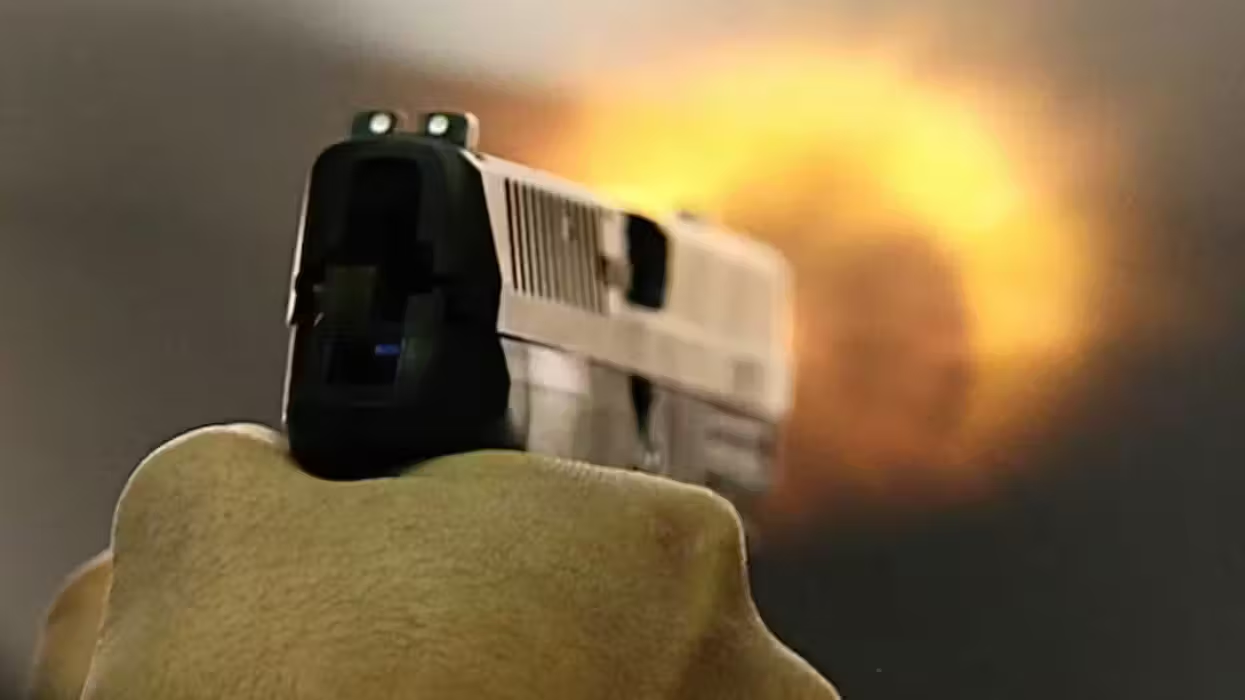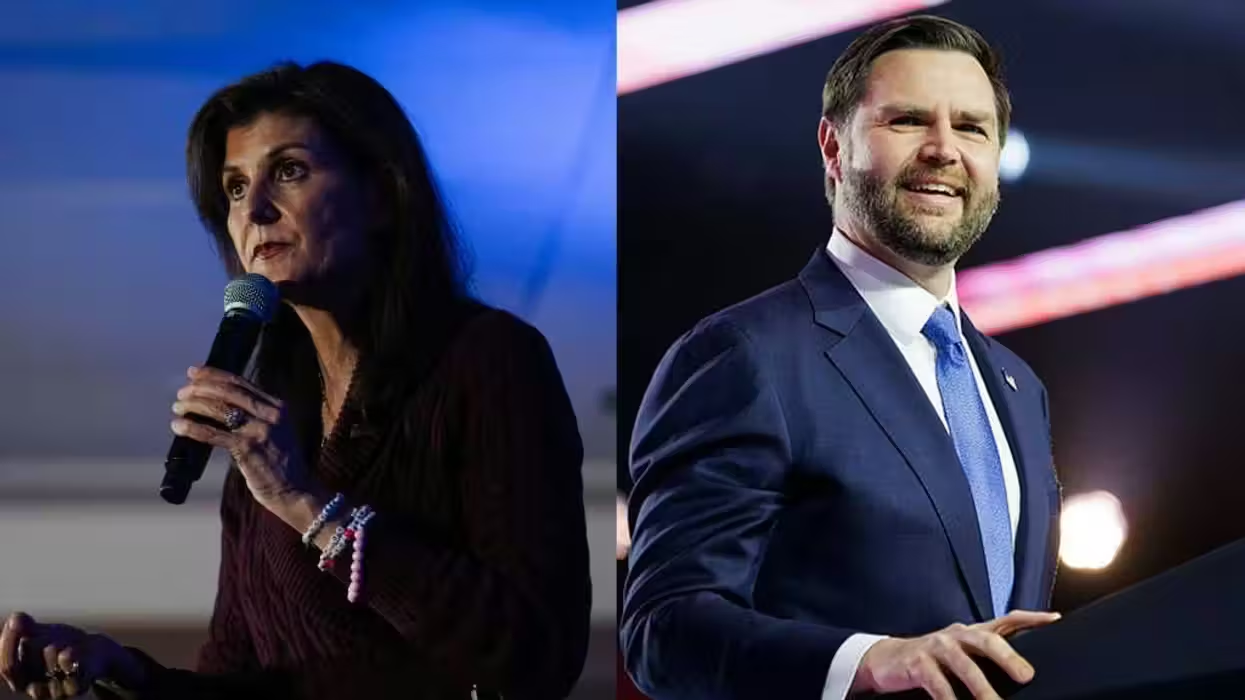
© 2026 Blaze Media LLC. All rights reserved.
"there’s much more still to these connections"
Editor's note: the following is a guest post by Paul Kengor, professor of political science and executive director of the Center for Vision & Values at Grove City College. This material is excerpted from his latest book Dupes: How America’s Adversaries Have Manipulated Progressives for a Century.
Hats off to The Blaze for being one of the few sources to investigate the coming “Day of Rage” planned by the radical left for September 17 (Saturday), where a motley crew of liberals, progressives, socialists, and communists—and it will not be easy to know which is which—hope to siege and “occupy” Wall Street. As The Blaze has noted, ringleaders include SEIU’s Stephen Lerner and ACORN’s Wade Rathke, who happen to be Obama supporters. The Blaze has also keenly noted the historic connection to the 1969 “Days of Rage” in Chicago, where the ringleaders included Bill Ayers and Bernardine Dohrn, who happen to be Obama supporters.
Alas, there’s much more still to these connections. Specifically, the literal communists who organized the original 1969 Days of Rage magically reappeared in 2008 to organize the group Progressives for Obama. Suddenly, they were “progressives” stumping for the presidential bid of Barack Obama. They include a bunch of names we should be remembering. That list of names is so vast that it can be overwhelming and bewildering, requiring a book to fully flesh out, but here I’ll focus on just a few who are key to understanding the rotten historical roots at play.

SDS
Behind the original “Days of Rage” in Chicago in 1969 was a major switch for ‘60s radicals. It was a switch in philosophy and tactics, from Students for a Democratic Society (SDS) to the Weathermen. Key players included not merely Ayers and Dohrn, but Mark Rudd, Tom Hayden, Jeff Jones, Michael Klonsky, Carl Davidson, John Jacobs, David Gilbert, and Kathy Boudin, among many others.
Especially influential was Mark Rudd. By 1969, Rudd had established himself as a household name. The SDS leader at Columbia University, Rudd led the riots on the campus in 1968, bull-horning the administration with vulgar obscenities, stomping, carrying signs, smashing windows and breaking down doors, pillaging and seizing the offices of the president and shutting down the entire campus. As a Newsweek cover attested, Rudd and the children were in charge. Student strikes ensued, and a general rage enveloped Columbia for weeks. It was sheer madness—what Rudd himself dubbed “total war” on campus. It had been orchestrated, from the top, by communists—American communists.
At long last at Columbia, it was October 1917; the revolution had finally commenced. As Rudd wrote in his SDS pamphlet, titled simply, “Columbia,” “It was no accident that we hung up pictures of Karl Marx and Malcolm X and Che Guevara and flew red flags from the tops of two buildings.”
And it was, SDS’s communists nationwide hoped, just the start. If only Columbia could be replicated upon the rest of America! Indeed, that became the goal: In Ramparts magazine, edited by young communists David Horowitz and Peter Collier, who today are prominent anti-communist conservatives, Tom Hayden wrote an article where he employed a new battle cry, a paraphrase of Saint Che’s mantra for Vietnam: “Create two, three, many Columbias!”
Hayden had been the most important initial player in the early SDS. He served as SDS president in 1962 and 1963, drafting its manifesto, the Port Huron Statement. Hayden’s fame and impact would spike up in 1968. He was arrested at the Democratic convention that year, becoming one of the “Chicago Seven,” along with Jerry Rubin and Abbie Hoffman, the latter of whom threatened to dump LSD in the city’s water supply.
That same year Hayden and an SDS delegation travelled to the Communist Bloc, where, according to observer Sol Stern, who was there as a privileged correspondent for the radical Ramparts, “The SDSers held a seminar with the communists on how to conduct their psychological warfare campaign against the United States.”
As for Hayden, Congress later published a June 4, 1968 letter he wrote to a Vietnamese colonel, wishing him and the Vietcong “Good fortune! Victory!”
Hayden’s notoriety surged when he took one of his controversial troops to Cambodia and Vietnam with the young actress Jane Fonda.
Of course, Jane herself is a huge story. The wealthy young actress was a go-go girl for communism, regularly telling student audiences: “[I]f you would understand what communism was, you would pray on your knees that we would someday be communist.” Once arriving in Hanoi, Jane became a cheerleader and glamour girl for the Vietcong. The trip was arranged (in part) by Wilfred Burchett (later identified as a Soviet agent), who also reportedly helped script Fonda’s talks. There, Jane became the literal toast of the communist world for her “heroics” on behalf of “anti-imperialism” and anti-Americanism. Her face was splashed across media everywhere—especially by an ecstatic communist press. As Jane grinned aboard and aside Vietcong weaponry, the Soviets and North Vietnamese were smitten.
And so was Tom Hayden. Shortly after Jane’s theatrics, Hayden married Fonda, his second wife.

From SDS to the Weathermen
By that point, SDS was finished as well. It was splintering into rival factions, the most infamous being a domestic communist-terrorist group called the Weathermen.
By Mark Rudd’s testimony, the political harlot that was Columbia University birthed the wretched child that was the Weathermen. In his own words, “Columbia would give birth to the ‘revolutionary’ faction known as Weatherman.”
And it was Rudd, more than any other figure, who helped sow SDS’s implosion during its irredeemably rotten transition to the Weather Underground. He and his cadre came together in the summer of ‘69 to form the Weathermen (also known as “Weatherman”).
Rudd later succinctly summed up the creation and the objective: “My friends and I formed an underground revolutionary guerrilla band called Weatherman which had as its goal the violent overthrow of the United States government.”
That was the stated intention of the Weathermen: the violent overthrow of the United States government.
The shift toward the Weathermen was the culmination of a deeper split within SDS. SDS had soured into an unpalatable witches’ brew of sincere anti-war liberals and hardcore Marxists, with the latter balkanizing into different factions, from Maoists to followers of Che and Fidel to even the occasional Stalinist, from the Progressive Labor wing to the Revolutionary Youth Movement (RYM) to the Weathermen.
It may seem unbelievable to imagine that there were Stalinists among them, but there were. According to Rudd, the Stalinists included Mike Klonsky. Klonsky was the SDS national secretary, based in Chicago, and was actually to the left of Mark Rudd. Rudd recalls a meeting in 1969 when Klonsky “several times” told Rudd and Howard Machtinger that “Stalin is the cutting edge.” This “adulation of Joseph Stalin” (Rudd’s description) made no sense to Rudd and Machtinger. It was such internal differences that created further instability among SDS principals, further driving a wedge that spawned the Weathermen.
Another critical area of separation, mercifully creating a much-needed wake-up call among the duped non-communist liberals in SDS, was the divergent feelings about violence. The typical rank-and-file SDS-er was an anti-war, pro-peace, non-violence liberal, whereas the members of the Weathermen ranged in their commitment to violence—to the point that the more violent went “underground” and formed the Weather Underground. Inside the Weather Underground, public expressions of aggression ranged from Mark Rudd’s initial open endorsements, which he would seem to privately regret and later repudiate, to the bomb-setting fanaticism of the likes of Bernardine Dohrn and Bill Ayers.
Violence was not the only reason to go underground: Many of the comrades were inspired by or interacting with foreign adversaries of the United States—a topic I’ll leave for another day.

Chicago, 1969: Days of Rage
In short, with all of those forces set in motion, the contours of the Weathermen began to emerge, which brings me to the Days of Rage. Two events in Chicago from June-October 1969 were precipitous: First, there was the final SDS National Convention. It opened June 18, 1969 at the Chicago Coliseum on South Wabash, just down the street from the Chicago police headquarters, home of the so-called “pigs” with who the Weathermen prepared for literal war. With America and its policemen and servicemen as the identified enemy, Che’s partisans were ready for action.
Next, with Rudd, Ayers, Dohrn, John Jacobs, and Jeff Jones taking the lead, the cadre came together in the “National Action,” held in Chicago from October 8-11, 1969, under the banner, “BRING THE WAR HOME!”—John Jacobs is credited as the author of that slogan—and with battle cries like, “Ho, Ho, Ho Chi Minh, NLF is going to win!”
The National Action had been planned a year earlier in Boulder, Colorado, where Jacobs had drafted the resolution. The title of the resolution was called, “The Elections Don’t Mean Sh-t—Vote Where the Power Is—Our Power Is In The Street.” Jacobs declared an “all-out civil war over Vietnam” and against “fascist U.S. imperialism.”
Rudd affirmed the cornerstone of the plan of action: “In Chicago the pigs have to be wiped out. We’re going to fight with violence and wipe out Chicago.” SDS planned to have 15,000 student demonstrators on hand in the city that October. The stated reason was to protest the trial of the Chicago Eight. But the trial was a mere pretense.
Joining Rudd and Jacobs for the festivities were Ayers, Dohrn, Hayden—on hand for an inspiring pep talk—Klonsky, David Gilbert, Kathy Boudin, and the other usual suspects. What ensued was an organized riot, commenced on October 5, 1969 when the “flower children” dynamited the statue commemorating the Chicago police who had been killed in the 1886 Haymarket Riot. As far as the “students” were concerned, these men were not Chicago’s finest, not veterans of the police force and (in many cases) World War II, but jackbooted swine. The smashed glass and damage caused by the explosion was a fitting initiation to the tirade that followed, eventually ending in violent clashes with over 1,000 policemen.
The day after the initial rampage, the student Reds were licking their wounds. Many were bruised and cut and beaten, or had spent a night in jail. They needed a pick-me-up. There to buck up the boys and girls the next day at a rally in Grant Park was Bernardine Dohrn. The former Milwaukee cheerleader was anointed the commissar to spearhead the “Women’s Militia.”
Mayor Daley’s police won the battle, but it was not a total loss for the student revolutionaries. Roughly 30 “pigs” were injured and a city official was paralyzed.
The National Action had become the Days of Rage. It was one of the ugliest nights in the history of Chicago.
And although no one noticed at the time, or has remarked since, that fall of 1969 had coincidentally marked the 50th anniversary of the founding of the American Communist Party in that same city. How fitting it was.
December 26, 1969: Flint War Council
There is much madness that flowed from this unholy event, which, again, requires a book to adequately flesh out, but here’s just one instance worth remembering:
As so often happens with extremist movements, the increasing violence among the revolutionaries was descending into a bloodlust.
To that end, the most infamous moment of the newly launched Weathermen was the appropriately titled “War Council” held in Flint, Michigan on December 27, 1969, attended by some 400 student troops. In the pamphlets, the jocular activists sweetly called the gathering a “Wargasm.”
Among the ringleaders, John Jacobs, with his knack for bombast, conjured up another fitting slogan. “We’re against everything that’s good and decent,” explained Jacobs.
That vulgar certainty was quickly made manifest when an indecent Bernardine Dohrn grabbed the microphone and went on a scorching rant. She described the group’s mission thusly: “We’re about being crazy motherf---ers and scaring the sh-t out of honky America!”
Like a radical revival meeting, Mark Rudd got caught up in the fervor, and found himself uttering words he later regretted: “It’s a wonderful feeling to hit a pig. It must be a really wonderful feeling to kill a pig or blow up something.”
Likewise moved by the spirit, Kathy Boudin declared all mothers of white children to be “pig mothers.” Invoking the unity of the Christmas season, she led the faithful in a new rendition of Bing Crosby’s “White Christmas:” “I’m Dreaming of a White Riot….,” she sang. Kathy then shouted about “doing some sh-t like political assassinations.”
Those sentiments were just the tip of the iceberg, especially in terms of what Bernardine was thinking. Much like Vladimir Lenin’s ever-widening category of people considered “harmful insects,” destined for death or the gulag, Bernardine’s category of “pigs” was rapidly expanding. In the very recent past, the pigs had been America’s police and boys in Vietnam. Now, Bernardine was about to enrich the brethren at the War Council with her thoughts on the vicious Tate-LaBianca murders executed by the satanic Charles Manson “family.” The victims would get no sympathy from the future childcare advocate, who, here in Flint, was hell-bent on herding their mutilated bodies into her widening “pigs” category.
The girl from the Midwest flew off the hinges, waxing lustfully over the demonic spectacle of the criminally insane mutilation of pregnant actress Sharon Tate and her friends by the swastika-tattooed Manson brood. The crime done by the Manson clan is too mortifying to describe here, particularly the ripping open of Tate’s belly, but it wasn’t to Bernardine Dohrn. The future professor of child education at Northwestern saw a kind of deliciousness in these true Manson “revolutionaries.” She imbibed at the image of the cabal’s dehumanization of Tate, gleefully sharing her feelings with the assembled. Dohrn thrilled:
Dig it! First they killed those pigs. Then they ate dinner in the same room with them. Then they even shoved a fork into the victim’s stomach! Wild!
It was two days after Christmas, when America was still celebrating the image of the birth of the Christ child. Bernardine, however, was celebrating the image of the slaughter of the Tate child.
One would like to say that this moment of gore shocked even the hardcore in that room, but that would not be accurate. The faithful, from

Bernadine’s sweetheart, Bill Ayers, to everyone else in the hall, knew that Bernardine was serious—and they dug it. As Mark Rudd reported, the assembled “instantly adopted as Weather’s salute four fingers held up in the air, invoking the fork left in Sharon Tate’s belly.”
Rudd translated this message for the wider world: “The message was that we sh-t on all your conventional values, you murderers of black revolutionaries and Vietnamese babies. There were no limits to our politics of transgression.”
No, there were not. And this is not quite the flowery image of the children dancing with daisies captured by liberal documentarians. Today, there is no Kodak moment of the four-finger salute thumb-tacked on the bulletin boards outside the office doors of the tenured radicals in their Ivy Towers, where idealistic education majors can take notes.
And now, a line had been crossed—the first steps into a dark world. Like the Jacobins after the first drop of the guillotine, the blood began to flow, rushing from the altar where Bishop Dohrn saluted and exhorted the faithful. Domestic terror cells, gunpowder, bomb-making units. A “new decade now dawned,” judged Rudd, as “the New Red Army marched out from Flint, exhilarated and terrified.”
And exhilarated to commit terror. The Weather Underground, and its blood orgy, was in full rot.
Progressives for Obama
And so where is this lovely crew now? That brings me to Progressives for Obama. The radicals reunited with renewed vigor in 2008, forming a group called Progressives for Obama, which was a Who’s Who—a reunion—of the 1960s SDS crowd. Whereas Bill Ayers was thrust into the national spotlight by conservative commentators, Progressives for Obama flew under the radar, largely unnoticed even by conservatives, and predictably ignored by the mainstream media which essentially served as an unofficial extension of the Obama presidential campaign.
Appropriately, spearheading Progressives for Obama was the man who had spearheaded SDS: Tom Hayden. Hayden was one of the four “initiators” of Progressives for Obama, along with Barbara Ehrenreich, Bill Fletcher, Jr., and Danny Glover. Amazingly, Hayden, who wrote the founding Port Huron manifesto for SDS, also penned the founding manifesto for Progressives for Obama.
Yes, Tom Hayden was the spearhead for both.
Beyond its initiators, Progressives for Obama featured a list of 94 formal “signers,” including Hayden’s ex-wife, Jane Fonda, and Mark Rudd, Carl Davidson, Thorne Dreyer, Daniel Ellsberg, Richard Flacks, John McAuliff, Jay Schaffner, and more. Columbia University was certainly represented, if not through the likes of Rudd, who once shut down the campus, then specifically through current faculty such as Todd Gitlin, a former SDS president who today is professor of journalism, sociology, and chair of Columbia’s doctoral program in communications.
It is no exaggeration to say that the list of Progressives for Obama resembled the roster of SDS-ers called to testify for their subversive activities in the 1960s, literally appearing throughout the index of the transcripts from Congress’ December 1969 investigation of SDS. Aside from the likes of Hayden, Rudd, and Davidson, other SDS-ers among Progressives for Obama are Bob Pardun, who was SDS education secretary from 1966-67, and Paul Buhle, a professor who has recently sought to revive SDS. And still yet more SDS-ers, some who became Weathermen, were not formal signers for Progressives for Obama but signed online petitions backing Obama’s candidacy. Petition signers from the old guard included Howard Machtinger, Jeff Jones, and Steve Tappis, among others. Others who testified in the 1960s, like Michael Klonsky, were represented in the 2008 list of Progressives for Obama by their relations, Anne Lowry Klonsky and Fred Klonsky, all now pervading the field of public education.
Again, much, much more could be said. Please believe me when I tell you that this is a tiny snapshot, a mere ice-cube from an iceberg.
And the most amazing and depressing thing is that all of this—as crazy and conspiratorial as it may sound—is true. You can’t make it up. It’s like America is suddenly reliving its 1960s nightmares, from the Days of Rage to the Day of Rage, from SDS to the Weathermen to Progressives for Obama. These folks never go away; they simply reappear, changing their names but not their ultimate intentions. It’s our goal to not be ignorant, to be informed of the crucial history and the crucial machinations at work right now.
When the comrades and their fellow travelers lay siege to Wall Street on September 17, it will be nothing new. Sadly, nothing new at all. America, wake up.
Want to leave a tip?
We answer to you. Help keep our content free of advertisers and big tech censorship by leaving a tip today.
Want to join the conversation?
Already a subscriber?
more stories
Sign up for the Blaze newsletter
By signing up, you agree to our Privacy Policy and Terms of Use, and agree to receive content that may sometimes include advertisements. You may opt out at any time.
Related Content
© 2026 Blaze Media LLC. All rights reserved.
Get the stories that matter most delivered directly to your inbox.
By signing up, you agree to our Privacy Policy and Terms of Use, and agree to receive content that may sometimes include advertisements. You may opt out at any time.






